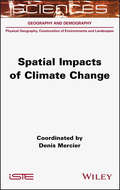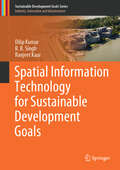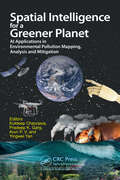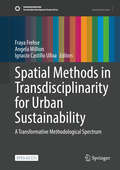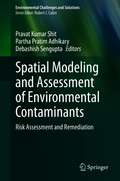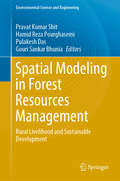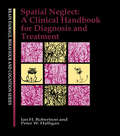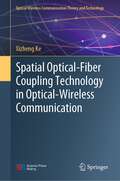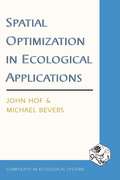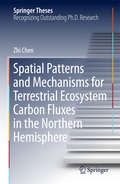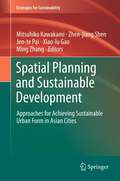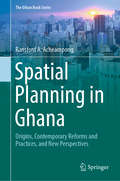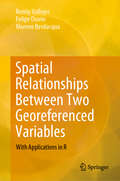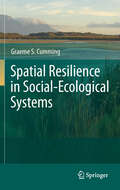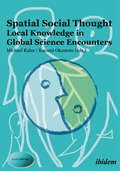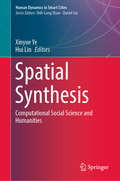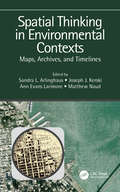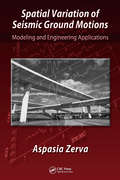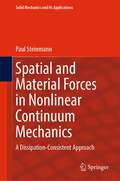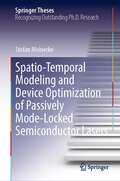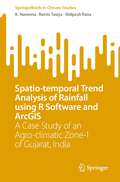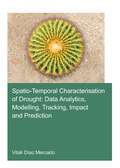- Table View
- List View
Spatial Impacts of Climate Change
by Denis MercierClimate change has been a central concern over recent years, with visible and highly publicized consequences such as melting Arctic ice and mountain glaciers, rising sea levels, and the submersion of low-lying coastal areas during mid-latitude and tropical cyclones. This book presents a review of the spatial impacts of contemporary climate change, with a focus on a systematic, multi-scalar approach. Beyond the facts – rises in temperature, changes in the spatial distribution of precipitation, melting of the marine and terrestrial cryosphere, changes in hydrological regimes at high and medium latitudes, etc. – it also analyzes the geopolitical consequences in the Arctic and Central Asia, changes to Mediterranean culture and to viticulture on a global scale, as well as impacts on the distribution of life, for example, in the Amazon rainforest, in large biomes on a global scale, and for birds.
Spatial Inequalities
by Allan G. Hill Justin Stoler John R. WeeksThis book provides a fresh analysis of the demography, health and well-being of a major African city. It brings a range of disciplinary approaches to bear on the pressing topics of urban poverty, urban health inequalities and urban growth. The approach is primarily spatial and includes the integration of environmental information from satellites and other geospatial sources with social science and health survey data. The authors Ghanaians and outsiders, have worked to understand the urban dynamics in this burgeoning West African metropolis, with an emphasis on urban disparities in health and living standards. Few cities in the global South have been examined from so many different perspectives. Our analysis employs a wide range of GIScience methods, including analysis of remotely sensed imagery and spatial statistical analysis, applied to a wide range of data, including census, survey and health clinic data, all of which are supplemented by field work, including systematic social observation, focus groups, and key informant interviews. This book aims to explain and highlight the mix of methods, and the important findings that have been emerging from this research, with the goal of providing guidance and inspiration for others doing similar work in cities of other developing nations.
Spatial Information Technology for Sustainable Development Goals (Sustainable Development Goals Series)
by Dilip Kumar R.B. Singh Ranjeet KaurThis textbook aims to develop a scientific knowledge base on spatial information technology to communicate the United Nations' Sustainable Development Goals (SDGs) among students, researchers, professionals and laymen. The book improves understanding of the spatial database and explains how to extract information from this for planning purposes. To enhance the knowledge of geoscientists and environmentalists, the book describes the basic fundamental concepts to advance techniques for spatial data management and analysis and discusses the methodology. The Geographic Information System (GIS), remote sensing and Global Positioning System (GPS) are presented in an integrated manner for the planning of resources and infrastructure. The management of these systems is discussed in a very lucid way to develop the reader's skills. The proper procedure for map making and spatial analysis are included along with case studies to the reader. Where the first part of the book discusses the conceptual background, the second part deals with case studies using these applications in different disciplines. The presented case studies include land use, agriculture, flood, watershed characterization and infrastructure assessment for the Sustainable Development Goals.
Spatial Intelligence for a Greener Planet: AI Applications in Environmental Pollution Mapping, Analysis and Mitigation
by Pradeep K. Garg Kuldeep Chaurasia P. V. Arun Yingwei YanWith rapid advancements in AI, this book reveals how AI can be a powerful tool in reducing pollution and fostering sustainability. It highlights the integration of geospatial techniques with AI for enhancing capabilities in mapping, analysis, and mitigation of environmental pollution. Starting with foundational concepts in AI, geospatial technology, and pollution, the book addresses air, water, soil and thermal pollution, emphasizing their harmful impacts. Through real-world case studies and advanced research, it showcases AI and geospatial technology's revolutionary role in pollution mitigation, exploring AI-driven sensors, satellite imagery, and associated networks for precise and efficient pollution monitoring and management.
Spatial Methods in Transdisciplinarity for Urban Sustainability: A Transformative Methodological Spectrum (Sustainable Development Goals Series)
by Angela Million Ignacio Castillo Ulloa Fraya FrehseThe book critically addresses the role of spatial methods in a transdisciplinary research-practice agenda regarding the promotion of urban sustainability throughout the globe with the aid of eight different, transdisciplinary approaches primarily based throughout the Global South and jointly penned by academics and practitioners. While the range of methodological discussions regarding research-and-practice collaborations between scientific researchers and local practitioners (based in NGOs, private firms or local government agencies) as well as independent policy-makers or artists for the purpose of urban sustainability has been thriving vastly over the last years, little attention has been paid to spatial methods in particular. This is not to mention their transdisciplinary use in urban contexts of the Global South. Resorting on empirical settings as diverse as Pretoria (South Africa), Porto Alegre and São Paulo (Brazil), Kolkata (India), Bangkok (Thailand) and Tshwane (South Africa) during the last four (partially Covid-19 pandemic) years as well as Tangerang (Indonesia) from 2001 to 2021, and San José (Costa Rica) between 2004 and 2007, the book sheds light on the following, twofold question: Which possibilities and limitations can spatial methods respectively unravel and encounter for transdisciplinary research and practice, in view of the SDG11 targets? By pursuing very diversified research-and-practice paths with the aid of specific combinations of spatial methods, each of the eight chapters makes evident the book’s central claim: the deployment of spatial methods in transdisciplinary projects for SDG11 has a transformative role. While some chapters especially highlight the personal dimension of the changes brought about to academics by the spatial-methodological, transdisciplinary experiments, others emphasize the academic reach of the spatial-methodological experience accomplished in and through transdisciplinarity. This is an open access book.
Spatial Modeling Principles in Earth Sciences
by Zekai SenSpatial Modeling Principles in Earth Sciences presents fundamentals of spatial data analysis used in hydrology, geology, meteorology, atmospheric science and related fields. It examines methods for the quantitative determination of the spatial distribution patterns. This book brings together the material from the current literature in earth sciences and practical examples. It provides a sound background of philosophical, logical, rational and physical principles of spatial data and analysis, and explains how it can be modeled and applied in earth sciences projects and designs. It collects information not previously available in one source, and provides methodology for the treatment of spatial data to find the most rational and practical solution. The book is a valuable resource for students, researchers and practitioners of a broad range of disciplines including geology, geography, hydrology, meteorology, environment, image processing, spatial modeling and related topics.
Spatial Modeling and Assessment of Environmental Contaminants: Risk Assessment and Remediation (Environmental Challenges and Solutions)
by Debashish Sengupta Pravat Kumar Shit Partha Pratim AdhikaryThis book demonstrates the measurement, monitoring and mapping of environmental contaminants in soil & sediment, surface & groundwater and atmosphere. This book explores state-of-art techniques based on methodological and modeling in modern geospatial techniques specifically focusing on the recent trends in data mining techniques and robust modeling. It also presents modifications of and improvements to existing control technologies for remediation of environmental contaminants. In addition, it includes three separate sections on contaminants, risk assessment and remediation of different existing and emerging pollutants. It covers major topics such as: Radioactive Wastes, Solid and Hazardous Wastes, Heavy Metal Contaminants, Arsenic Contaminants, Microplastic Pollution, Microbiology of Soil and Sediments, Soil Salinity and Sodicity, Aquatic Ecotoxicity Assessment, Fluoride Contamination, Hydrochemistry, Geochemistry, Indoor Pollution and Human Health aspects. The content of this book will be of interest to researchers, professionals, and policymakers whose work involves environmental contaminants and related solutions.
Spatial Modeling in Forest Resources Management: Rural Livelihood and Sustainable Development (Environmental Science and Engineering)
by Hamid Reza Pourghasemi Gouri Sankar Bhunia Pravat Kumar Shit Pulakesh DasThis book demonstrates the measurement, monitoring, mapping, and modeling of forest resources. It explores state-of-the-art techniques based on open-source software & R statistical programming and modeling specifically, with a focus on the recent trends in data mining/machine learning techniques and robust modeling in forest resources.Discusses major topics such as forest health assessment, estimating forest biomass & carbon stock, land use forest cover (LUFC), dynamic vegetation modeling (DVM) approaches, forest-based rural livelihood, habitat suitability analysis, biodiversity and ecology, and biodiversity, the book presents novel advances and applications of RS-GIS and R in a precise and clear manner. By offering insights into various concepts and their importance for real-world applications, it equips researchers, professionals, and policy-makers with the knowledge and skills to tackle a wide range of issues related to geographic data, including those with scientific, societal, and environmental implications.
Spatial Neglect: A Clinical Handbook for Diagnosis and Treatment (Brain, Behaviour and Cognition)
by Ian Robertson Peter W HalliganSpatial neglect is a profound clinical problem as well as intriguing scientific problem. In the last ten years, there has been an explosion of interest in this disorder, which as a result is no longer viewed as a single entity, but rather as a number of different disorders. This book is an attempt to bring the reader up to date with the latest advances in understanding neglect, at least insofar as this contributes to better clinical assessment, management and treatment. This is not a book for the specialist researcher in the neuropsychology of neglect and attention. Rather, it is a book aimed at clinicians - student and trained - from all disciplines involved in the assessment, management and treatment of neglect.The book begins with the description of four cases manifesting different types of unilateral neglect. The reader is introduced to different aspects of neglect through these patients. These distinctions include those between personal and extrapersonal neglect, motor versus sensory neglect and many others. The reader is also introduced to other phenomena that are closely related to neglect, including ansognosia and impaired sustained attention. The latest methodes of assessment of neglect are also described, as are methods of treatment, again with reference to the four introductory specimen cases.
Spatial Observation of Giant Panda Habitat: Techniques and Methods
by Xinyuan Wang Jing Zhen Qingkai MengThis book evaluates the past, present, and future habitat suitability of giant pandas based on spatial observation technology involving optical remote sensing, microwave remote sensing, and LiDAR to discover the mysterious ecological environment of giant panda habitat. Considering the problems faced by the world natural heritage site protection, it takes the world natural heritage site “Sichuan Giant Panda Sanctuaries – Wolong, Mt Siguniang and Jiajin Mountains” as the research area, exemplifies systematically the various techniques and methodologies of spatial information technology for monitoring, evaluation, and prediction of rare and endangered species habitats, and provides scientific suggestions for sustainable development of giant panda habitat based on a series of comprehensive case analysis at Wolong national nature reserve and Ya'an prefecture, Sichuan province, China. The book serves both as a textbook in the field of natural heritage protection, remote sensing, and GIS application, as well as a reference for managing natural heritage sites.
Spatial Optical-Fiber Coupling Technology in Optical-Wireless Communication (Optical Wireless Communication Theory and Technology)
by Xizheng KeThis book analyzes the development of space light-fiber coupling research, highlights its importance, examines the underlying theory and key problems, and elaborates on methods to improve the space light-fiber coupling efficiency. Starting from the basic theory of electromagnetic field, the transmission characteristics of light in optical fibers are expounded, and the coupling characteristics of optical signals of different modes are investigated. The spatial light-fiber coupling techniques such as mode conversion method, lens coupling method, and wavefront distortion correction method are discussed in detail, and the key technologies involved are verified by experiments. This book is suitable for the vast majority of engineering and technical personnel and teachers in colleges and institutions who are engaged in wireless optical communication. It can also be used to train senior undergraduates and graduate students in relevant fields.
Spatial Optimization in Ecological Applications (Complexity in Ecological Systems)
by Michael Bevers John HofWhether discussing habitat placement for the northern spotted owl or black-tailed prairie dog or strategies for controlling exotic pests, this book explains how capturing ecological relationships across a landscape with pragmatic optimization models can be applied to real world problems. Using linear programming, Hof and Bevers show how it is possible for the researcher to include many thousands of choice variables and many thousands of constraints and still be quite confident of being able to solve the problem in hand with widely available software. The authors' emphasis is to preserve optimality and explore how much ecosystem function can be captured, stressing the solvability of large problems such as those in real world case studies.
Spatial Patterns and Mechanisms for Terrestrial Ecosystem Carbon Fluxes in the Northern Hemisphere (Springer Theses)
by Zhi ChenThis book systematically illustrates the underlying mechanisms of spatial variation in ecosystem carbon fluxes. It presents the regulation of climate pattern, together with its impacts on ecosystem traits, which yields new insights into the terrestrial carbon cycle and offers a theoretic basis for large-scale carbon pattern assessment. By means of integrated analysis, the clear spatial pattern of carbon fluxes (including gross primary production, ecosystem respiration and net ecosystem production) along latitudes is clarified, from regions to the entire Northern Hemisphere. Temperature and precipitation patterns play a vital role in carbon spatial pattern formation, which strongly supports the application of the climate-driven theory to the Northern Hemisphere. With regard to the spatial pattern, the book demonstrates the covariation between production and respiration, offering new information to promote current respiration model development. Moreover, it reveals the high carbon uptake of subtropical forests across the East Asian monsoon region, which challenges the view that only mid- to high-latitude terrestrial ecosystems are principal carbon sink regions, and improves our understanding of carbon budgets and distribution.
Spatial Planning and Sustainable Development
by Ming Zhang Jen-Te Pai Mitsuhiko Kawakami Xiao-Lu Gao Zhen-Jiang ShenThis book attempts to provide insights into the achievement of a sustainable urban form, through spatial planning and implementation; here, we focus on planning experiences at the levels of local cities and some metropolitan areas in Asian countries. This book investigates the impact of planning policy on spatial planning implementation, from multidisciplinary viewpoints encompassing land-use patterns, housing development, transportation, green design, and agricultural and ecological systems in the urbanization process. We seek to learn from researchers in an integrated multidisciplinary platform that reflects a variety of perspectives, such as economic development, social equality, and ecological protection, with a view to achieving a sustainable urban form.
Spatial Planning in Ghana: Origins, Contemporary Reforms And Practices, And New Perspectives (The Urban Book Series)
by Ransford A. AcheampongThis book documents and analyses spatial planning in Ghana, providing a comprehensive and critical discussion of the evolving institutional and legal arrangements that have shaped and defined Ghana’s spatial planning system for more than seven decades; the contemporary policy instruments and mechanisms for articulating and implementing policies and proposals at multiple scales; and the formally established procedures for development management. It covers important themes in contemporary spatial planning discourse, including the evolving meaning, scope and purpose of spatial planning globally; the scales of spatial planning (i.e. national, regional, sub-regional and local); multi-level integration within spatial planning; public participation; the interface between urbanization, sustainable growth management and spatial planning; spatial planning and housing development; integrated spatial development and transportation planning; and spatial planning and the urban informal economy. Intended for undergraduate and graduate students, and academic researchers and practitioners/policy-makers in the multidisciplinary field of spatial planning, it appeals to readers seeking an international perspective on spatial planning systems and practices.
Spatial Relationships Between Two Georeferenced Variables: With Applications in R
by Ronny Vallejos Felipe Osorio Moreno BevilacquaThis book offers essential, systematic information on the assessment of the spatial association between two processes from a statistical standpoint. Divided into eight chapters, the book begins with preliminary concepts, mainly concerning spatial statistics. The following seven chapters focus on the methodologies needed to assess the correlation between two or more processes; from theory introduced 35 years ago, to techniques that have only recently been published. Furthermore, each chapter contains a section on R computations to explore how the methodology works with real data. References and a list of exercises are included at the end of each chapter. The assessment of the correlation between two spatial processes has been tackled from several different perspectives in a variety of applications fields. In particular, the problem of testing for the existence of spatial association between two georeferenced variables is relevant for posterior modeling and inference. One evident application in this context is the quantification of the spatial correlation between two images (processes defined on a rectangular grid in a two-dimensional space). From a statistical perspective, this problem can be handled via hypothesis testing, or by using extensions of the correlation coefficient. In an image-processing framework, these extensions can also be used to define similarity indices between images.
Spatial Resilience in Social-Ecological Systems
by Graeme S. CummingSpatial Resilience is a new and exciting area of interdisciplinary research. It focuses on the influence of spatial variation - including such things as spatial location, context, connectivity, and dispersal - on the resilience of complex systems, and on the roles that resilience and self-organization play in generating spatial variation. Prof. Cumming provides a readable introduction and a first comprehensive synthesis covering the core concepts and applications of spatial resilience to the study of social-ecological systems. The book follows a trajectory from concepts through models, methods, and case study analysis before revisiting the central problems in the further conceptual development of the field. In the process, the author ranges from the movements of lions in northern Zimbabwe to the urban jungles of Europe, and from the collapse of past societies to the social impacts of modern conflict. The many case studies and examples discussed in the book show how the concept of spatial resilience can generate valuable insights into the spatial dynamics of social-ecological systems and contribute to solving some of the most pressing problems of our time. Although it has been written primarily for students, this book will provide fascinating reading for interdisciplinary scientists at all career stages as well as for the interested public. "Graeme Cumming, central in the development of resilience thinking and theory, has produced a wonderful book on spatial resilience, the first ever on this topic. The book will become a shining star, a classic in the explosion of new ideas and approaches to studying and understanding social-ecological systems." Carl Folke, Stockholm Resilience Centre, Sweden
Spatial Social Thought: Local Knowledge in Global Science Encounters
by Michael Kuhn Kazumi OkamotoThis volume presents perspectives on spatially construed knowledge systems and their struggle to interrelate. Western social sciences tend to be wrapped up in very specific, exclusionary discourses, and Northern and Southern knowledge systems are sidelined. Spatial Social Thought reimagines the social sciences as a place of encounter between all spatially bound, parochial knowledge systems.
Spatial Synthesis: Computational Social Science and Humanities (Human Dynamics in Smart Cities)
by Xinyue Ye Hui LinThis book describes how powerful computing technology, emerging big and open data sources, and theoretical perspectives on spatial synthesis have revolutionized the way in which we investigate social sciences and humanities. It summarizes the principles and applications of human-centered computing and spatial social science and humanities research, thereby providing fundamental information that will help shape future research. The book illustrates how big spatiotemporal socioeconomic data facilitate the modelling of individuals’ economic behavior in space and time and how the outcomes of such models can reveal information about economic trends across spatial scales. It describes how spatial social science and humanities research has shifted from a data-scarce to a data-rich environment. The chapters also describe how a powerful analytical framework for identifying space-time research gaps and frontiers is fundamental to comparative study of spatiotemporal phenomena, and how research topics have evolved from structure and function to dynamic and predictive. As such this book provides an interesting read for researchers, students and all those interested in computational and spatial social sciences and humanities.
Spatial Thinking in Environmental Contexts: Maps, Archives, and Timelines
by Joseph J. Kerski Sandra L. Arlinghaus Ann Evans Larimore Matthew NaudSpatial Thinking in Environmental Contexts: Maps, Archives, and Timelines cultivates the spatial thinking "habit of mind" as a critical geographical view of how the world works, including how environmental systems function, and how we can approach and solve environmental problems using maps, archives, and timelines. The work explains why spatial thinking matters as it helps readers to integrate a variety of methods to describe and analyze spatial/temporal events and phenomena in disparate environmental contexts. It weaves together maps, GIS, timelines, and storytelling as important strategies in examining concepts and procedures in analyzing real-world data and relationships. The work thus adds significant value to qualitative and quantitative research in environmental (and related) sciences. Features Written by internationally renowned experts known for taking complex ideas and finding accessible ways to more broadly understand and communicate them. Includes real-world studies explaining the merging of disparate data in a sensible manner, understandable across several disciplines. Unique approach to spatial thinking involving animated maps, 3D maps, GEOMATs, and story maps to integrate maps, archives, and timelines—first across a single environmental example and then through varied examples. Merges spatial and temporal views on a broad range of environmental issues from traditional environmental topics to more unusual ones involving urban studies, medicine, municipal/governmental application, and citizen-scientist topics. Provides easy to follow step-by-step instructions to complete tasks; no prior experience in data processing is needed.
Spatial Variation of Seismic Ground Motions: Modeling and Engineering Applications (Advances in Engineering Series)
by Aspasia ZervaThe spatial variation of seismic ground motions denotes the differences in the seismic time histories at various locations on the ground surface. This text focuses on the spatial variability of the motions that is caused by the propagation of the waveforms from the earthquake source through the earth strata to the ground surface, and it brings toge
Spatial and Material Forces in Nonlinear Continuum Mechanics: A Dissipation-Consistent Approach (Solid Mechanics and Its Applications #272)
by Paul SteinmannThis monograph details spatial and material vistas on non-linear continuum mechanics in a dissipation-consistent approach. Thereby, the spatial vista renders the common approach to nonlinear continuum mechanics and corresponding spatial forces, whereas the material vista elaborates on configurational mechanics and corresponding material or rather configurational forces. Fundamental to configurational mechanics is the concept of force. In analytical mechanics, force is a derived object that is power conjugate to changes of generalised coordinates. For a continuum body, these are typically the spatial positions of its continuum points. However, if in agreement with the second law, continuum points, e.g. on the boundary, may also change their material positions. Configurational forces are then power conjugate to these configurational changes. A paradigm is a crack tip, i.e. a singular part of the boundary changing its position during crack propagation, with the related configurational force, typically the J-integral, driving its evolution, thereby consuming power, typically expressed as the energy release rate. Taken together, configurational mechanics is an unconventional branch of continuum physics rationalising and unifying the tendency of a continuum body to change its material configuration. It is thus the ideal formulation to tackle sophisticated problems in continuum defect mechanics. Configurational mechanics is entirely free of restrictions regarding geometrical and constitutive nonlinearities and offers an accompanying versatile computational approach to continuum defect mechanics. In this monograph, I present a detailed summary account of my approach towards configurational mechanics, thereby fostering my view that configurational forces are indeed dissipation-consistent to configurational changes.
Spatio-Temporal Modeling and Device Optimization of Passively Mode-Locked Semiconductor Lasers (Springer Theses)
by Stefan MeineckeThis thesis investigates passively mode-locked semiconductor lasers by numerical methods. The understanding and optimization of such devices is crucial to the advancement of technologies such as optical data communication and dual comb spectroscopy. The focus of the thesis is therefore on the development of efficient numerical models, which are able both to perform larger parameter studies and to provide quantitative predictions. Along with that, visualization and evaluation techniques for the rich spatio-temporal laser dynamics are developed; these facilitate the physical interpretation of the observed features.The investigations in this thesis revolve around two specific semiconductor devices, namely a monolithically integrated three-section tapered quantum-dot laser and a V-shaped external cavity laser. In both cases, the simulations closely tie in with experimental results, which have been obtained in collaboration with the TU Darmstadt and the ETH Zurich. Based on the successful numerical reproduction of the experimental findings, the emission dynamics of both lasers can be understood in terms of the cavity geometry and the active medium dynamics. The latter, in particular, highlights the value of the developed simulation tools, since the fast charge-carrier dynamics are generally not experimentally accessible during mode-locking operation. Lastly, the numerical models are used to perform laser design explorations and thus to derive recommendations for further optimizations.
Spatio-temporal Trend Analysis of Rainfall using R Software and ArcGIS: A Case Study of an Agro-climatic Zone-1 of Gujarat, India (SpringerBriefs in Climate Studies)
by K. Naveena Ramiz Tasiya Shilpesh RanaThis book aims to provide an advanced R software approach that can carry out rainfall trend analysis using Mann-Kendall and Sen’s slope estimator tests. The research study follows a systematic approach while utilizing R software as it can greatly facilitate the analysis of rainfall trends. About 30 stations located in the study area and 41 to 50 years’ time series were selected for the purpose of analysis. The data for the research was collected from the State Water Data Centre (SWDC) in Gujarat, Indian Meteorological Department (IMD) in Pune, DAAC (NASA), and ESRI. Cluster analysis has been performed to analyze the variability of the mean rainfall. The stations have been divided into 2 clusters with 17 and 13 stations in each cluster which significantly differ from each other. This book is aimed at researchers, scientists and government organizations working in the field of climate change.
Spatio-temporal characterisation of drought: data analytics, modelling, tracking, impact and prediction (IHE Delft PhD Thesis Series)
by Vitali Diaz MercadoStudies of drought have increased in light of new data availability and advances in spatio-temporal analysis. However, the following gaps still need to be filled: 1) methods to characterise drought that explicitly consider its spatio-temporal features, such as spatial extent (area) and pathway; 2) methods to monitor and predict drought that include the above-mentioned characteristics and 3) approaches for visualising and analysing drought characteristics to facilitate interpretation of its variation. This research aims to explore, analyse and propose improvements to the spatio-temporal characterisation of drought. Outcomes provide new perspectives towards better prediction. The following objectives were proposed. 1) Improve the methodology for characterising drought based on the phenomenon’s spatial features. 2) Develop a visual approach to analysing drought variations. 3) Develop a methodology for spatial drought tracking. 4) Explore machine learning (ML) techniques to predict crop-yield responses to drought. The four objectives were addressed and results are presented. Finally, a scope was formulated for integrating ML and the spatio-temporal analysis of drought. Proposed scope opens a new area of potential for drought prediction (i.e. predicting spatial drought tracks and areas). It is expected that the drought tracking and prediction method will help populations cope with drought and its severe impacts.
